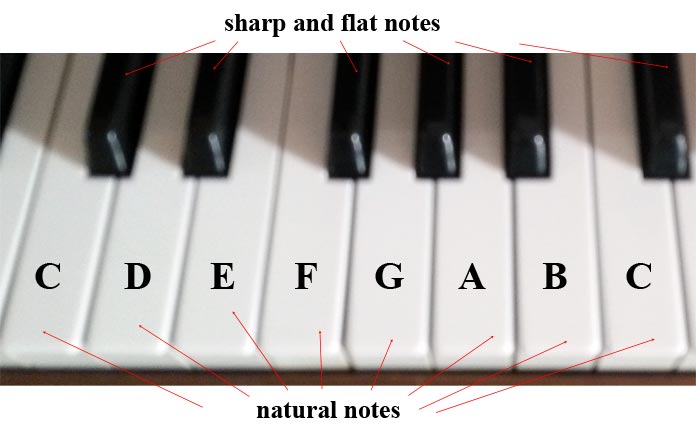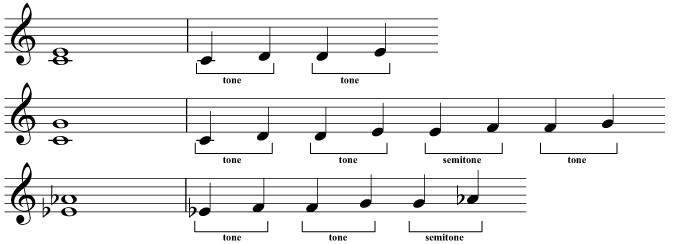Tones and semitones
In this guide...
Key terms:
Subscription required!
To view the complete study guide, you will need a valid subscription. Why not subscribe now?
Already have a subscription? Make sure you login first!
Introduction
Before we start looking at keys and scales, let's have a reminder of two basic building blocks of music: tones and semitones.
"In Between"
Recall the names of the natural notes: C, D, E, F, G, A, B, and remember the notes "in between" these natural notes: flats and sharps.
It might seem strange at first that there can be notes "in between" the natural notes (C, D, E, etc.). The sharp and flat notes really stand out on a piano keyboard - they are the "black notes" and the natural notes are the "white notes".
As you can see from the photo below, there are no sharps or flats between B and C or between E and F.
 Sharp, flat, and natural notes on a piano keyboard
Sharp, flat, and natural notes on a piano keyboardTones and semitones
The gap between a natural note and its sharpened version is an interval called a semitone, and the reason that there is no sharp (or flat) note between B and C or between E and F is because these natural notes are already a semitone apart, and so there is no "room" for a sharp or flat between them.
The interval between two natural notes which is large enough to contain a note "in between" - a flat or sharp - is called a tone. Therefore, there are tones between these pairs of natural notes:
- C and D
- D and E
- F and G
- G and A
- A and B
The number 12
As we saw when looking at flats and sharps, the number 12 keeps cropping up in music theory. Here it is again!
Where? Well, how many semitones are there in one octave?
12!
Building blocks
Two semitones can be "added" together to form a tone, and we can think further of tones and semitones as "building blocks", in two ways.
Semitones and tones...
- ...can be stacked on top of each other to form a larger interval
- ...can be arranged in sequences to form a scale
In intervals
We will look at intervals in much greater detail in several more advanced study guides, but here are a few simple examples of how some intervals are built from tones and semitones.
 Forming larger intervals from semitones and tones
Forming larger intervals from semitones and tonesIn scales
As with intervals, we'll look at scales a lot more in later guides. Here, however, is an example of how tones and semitones form the C major scale, which is another way of thinking of the natural notes in sequence.
 Forming a C major scale from semitones and tones
Forming a C major scale from semitones and tonesAs you become familiar with music, the patterns formed by semitones and tones will become second nature, but it's always useful to think of these basic intervals as the humble building blocks from which great music is made!
Read more...
With a subscription to Clements Theory you'll be able to read this and dozens of other study guides, along with thousands of practice questions and more! Why not subscribe now?
Revision
Are you sure you've understood everything in this study guide? Why not try the following practice questions, just to be sure!